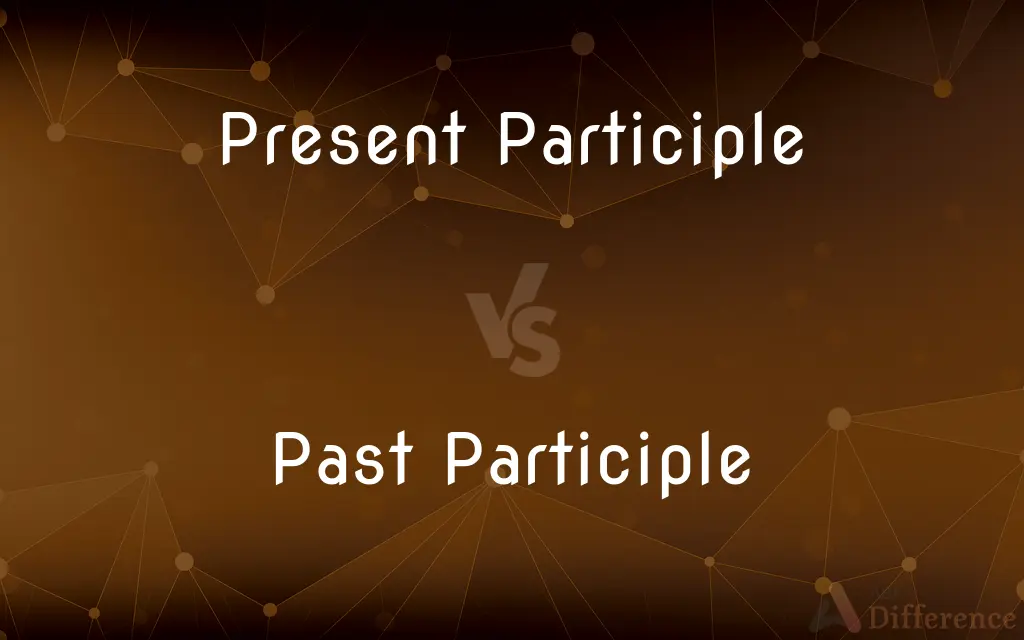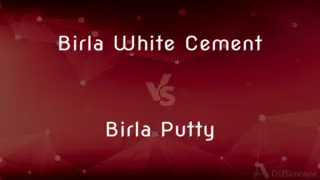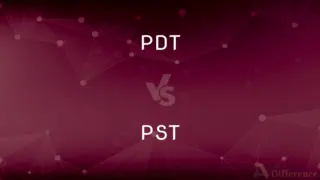Present Participle vs. Past Participle — What's the Difference?
By Tayyaba Rehman — Published on November 7, 2023
The present participle is formed by adding "-ing" to a verb and indicates ongoing action, while the past participle often ends in "-ed" or "-en" and indicates a completed action.

Difference Between Present Participle and Past Participle
Table of Contents
ADVERTISEMENT
Key Differences
The present participle is formed by appending "-ing" to the base form of a verb. The past participle, however, typically ends in "-ed" for regular verbs and varies for irregular verbs.
Present participles depict actions that are currently happening or ongoing. Past participles, on the other hand, signify actions that have been completed.
One can use the present participle to form continuous tenses, like "She is running." The past participle helps in forming perfect tenses, like "She has run."
In the capacity of adjectives, the present participle describes something causing an effect (e.g., "a boring movie"), whereas the past participle describes something that has been affected (e.g., "a broken toy").
While both can function as adjectives, the present participle often carries an active meaning, and the past participle a passive one.
ADVERTISEMENT
Comparison Chart
Formation
Adds "-ing" to base verb
Regular verbs add "-ed", irregulars vary
Action
Ongoing action
Completed action
Tense Formation
Used in continuous tenses
Used in perfect tenses
As Adjectives
Often has active meaning
Often has passive meaning
Examples
Running, swimming
Run, swum
Compare with Definitions
Present Participle
Can act as an adjective describing active events.
The laughing child played.
Past Participle
Acts as an adjective describing something affected.
The written words were profound.
Present Participle
Expresses actions that are in progress.
The water is boiling; be careful.
Past Participle
Indicates a completed action or state.
The letter has been sent.
Present Participle
Present participle is the "-ing" form of a verb.
She is reading a book.
Past Participle
Used in passive voice constructions.
The song was sung by her.
Present Participle
It denotes ongoing actions.
The sun is shining brightly.
Past Participle
Past participle often ends with "-ed" for regular verbs.
She has worked all day.
Present Participle
Often used with forms of "be" to create continuous tenses.
They are studying for exams.
Past Participle
Commonly paired with "have" to form perfect tenses.
They have finished their task.
Common Curiosities
When is the present participle typically used?
It's used to depict ongoing actions, often in continuous tenses.
In which tenses is the past participle used?
It's primarily used in perfect tenses and passive constructions.
Can both participles function as adjectives?
Yes, both can act as adjectives, with the present participle often having an active meaning and the past participle a passive one.
How do you form the past participle for regular verbs?
For regular verbs, you typically add "-ed" to the base form.
Is the past participle always formed by adding "-ed"?
No, that rule applies to regular verbs. Irregular verbs have varied forms.
What's an example of an irregular verb's past participle?
For the verb "go," the past participle is "gone."
Can you provide an example of a verb's present participle?
Sure, for the verb "write," the present participle is "writing."
What's the formation of the present participle?
It's formed by adding "-ing" to the base verb.
Can the past participle indicate something affected by an action?
Yes, like "burnt toast" indicates toast that has been affected by burning.
Is the present participle always active in meaning?
Mostly, yes. For instance, "a crying baby" suggests the baby is actively crying.
How do you distinguish between the two participles in a sentence?
Look at the context. If it's showing ongoing action, it's likely the present participle. If it's showing a completed action or state, it's the past participle.
Do all verbs have a distinct past participle form?
No, while many do, some verbs have the same form for the base, past, and past participle.
In what cases is the present participle commonly seen?
Besides continuous tenses, it's often seen in phrases like "while running" or "by writing."
When is the past participle used in passive voice?
It's used with a form of "be," like "The book was written by the author."
Can both participles be used in compound verb tenses?
Yes, the present participle in continuous tenses and the past participle in perfect and passive tenses.
Share Your Discovery

Previous Comparison
Birla White Cement vs. Birla Putty
Next Comparison
PDT vs. PSTAuthor Spotlight
Written by
Tayyaba RehmanTayyaba Rehman is a distinguished writer, currently serving as a primary contributor to askdifference.com. As a researcher in semantics and etymology, Tayyaba's passion for the complexity of languages and their distinctions has found a perfect home on the platform. Tayyaba delves into the intricacies of language, distinguishing between commonly confused words and phrases, thereby providing clarity for readers worldwide.













































